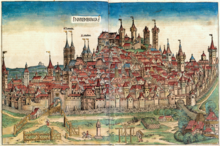A paper mill is a factory devoted to making paper from vegetable fibres such as wood pulp, old rags and other ingredients using a Fourdrinier machine or other type of paper machine.





Stromer's paper mill, the building complex at the far right bottom, in the Nuremberg Chronicle of 1493. Due to their noise and smell, papermills were required by medieval law to be erected some distance from the city walls.

A mid Nineteenth century paper mill, the Forest Fibre Company, in Berlin, New Hampshire.

Basement of paper mill in Sault Ste. Marie, Ontario. Pulp and paper manufacture involves a great deal of humidity, which presents a preventive maintenance andcorrosion challenge.

The Diamond Sutra of the Chinese Tang Dynasty, the oldest dated printed book in the world, found at Dunhuang, from 868 CE.
Papermaking is the process of making paper, a substance which is used universally today for writing and packaging.
In papermaking a dilute suspension of fibres in water is drained through a screen, so that a mat of randomly interwoven fibres is laid down. Water is removed from this mat of fibres by pressing and drying to make paper. Since the invention of the Fourdrinier machine in the 19th century, most paper has been made from wood pulp because of cost. But other fibre sources such as cotton and textiles are used for high-quality papers. One common measure of a paper's quality is its non-woodpulp content, e.g., 25% cotton, 50% rag, etc.
Papermaking, regardless of the scale on which it is done, involves making a dilute suspension of fibres in water and allowing this suspension to drain through a screen so that a mat of randomly interwoven fibres is laid down. Water is removed from this mat of fibres by pressing and drying to make paper.
First the fibres are suspended in water to form a slurry in a large vat. The mold is a wire screen in a wooden frame (somewhat similar to an old window screen), which is used to scoop some of the slurry out of the vat. The slurry in the screen mold is sloshed around the mold until it forms a uniform thin coating. The fibres are allowed to settle and the water to drain. When the fibres have stabilized in place but are still damp, they are turned out onto a felt sheet which was generally made of an animal product such as wool or rabbit fur, and the screen mold immediately reused. Layers of paper and felt build up in a pile (called a 'post') then a weight is placed on top to press out excess water and keep the paper fibres flat and tight. The sheets are then removed from the post and hung or laid out to dry. A step-by-step procedure for making paper with readily available materials can be found online.[13]
When the paper pages are dry, they are frequently run between rollers (calendered) to produce a harder writing surface. Papers may be sized with gelatin or similar to bind the fibres into the sheet. Papers can be made with different surfaces depending on their intended purpose. Paper intended for printing or writing with ink is fairly hard, while paper to be used for water color, for instance, is heavily sized, and can be fairly soft.
The wooden frame is called a "deckle". The deckle leaves the edges of the paper slightly irregular and wavy, called "deckle edges", one of the indications that the paper was made by hand. Deckle-edged paper is occasionally mechanically imitated today to create the impression of old-fashioned luxury. The impressions in paper caused by the wires in the screen that run sideways are called "laid lines" and the impressions made, usually from top to bottom, by the wires holding the sideways wires together are called "chain lines". Watermarks are created by weaving a design into the wires in the mold. This is essentially true of Oriental molds made of other substances, such as bamboo. Hand-made paper generally folds and tears more evenly along the laid lines.
Hand-made paper is also prepared in laboratories to study papermaking and to check in paper mills the quality of the production process. The "handsheets" made according to TAPPI Standard T 205[14] are circular sheets 15.9 cm (6.25 in) in diameter and are tested on paper characteristics as paper brightness, strength, degree of sizing.[15]
Paper banknotes
Most banknotes are made from cotton paper (see also paper) with a weight of 80 to 90 grams per square meter. The cotton is sometimes mixed with linen,abaca, or other textile fibres. Generally, the paper used is different from ordinary paper: it is much more resilient, resists wear and tear (the average life of a banknote is two years),[16] and also does not contain the usual agents that make ordinary paper glow slightly under ultraviolet light. Unlike most printing and writing paper, banknote paper is infused with polyvinyl alcohol or gelatin to give it extra strength. Early Chinese banknotes were printed on paper made ofmulberry bark and this fiber is used in Japanese banknote paper today.
Most banknotes are made using the mould made process in which a watermark and thread is incorporated during the paper forming process. The thread is a simple looking security component found in most banknotes. It is however often rather complex in construction comprising fluorescent, magnetic, metallic and micro print elements. By combining it with watermarking technology the thread can be made to surface periodically on one side only. This is known as windowed thread and further increases the counterfeit resistance of the banknote paper. This process was invented by Portals, part of the De La Rue group in the UK. Other related methods include watermarking to reduce the number of corner folds by strengthening this part of the note, coatings to reduce the accumulation of dirt on the note, and plastic windows in the paper that make it very hard to copy.




No comments:
Post a Comment